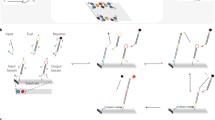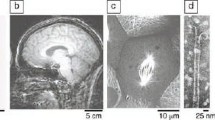Abstract
This article describes a novel approach to the implementation on an electronic substrate of a process analogous to the cellular division of biological organisms. Cellular division is one of the two processes that allow the multicellular organization of complex living beings, and is therefore a key mechanism for the implementation of bio-inspired features such as development (growth) and self-repair (cicatrization). In particular, we shall describe the architecture and operation of a new kind of programmable logic device capable of realizing, in silicon, a cellular division process.
Access this chapter
Tax calculation will be finalised at checkout
Purchases are for personal use only
Preview
Unable to display preview. Download preview PDF.
Similar content being viewed by others
References
Codd, E., F.: Cellular Automata. Academic Press, New York (1968)
Ibáñez, J., Anabitarte, D., Azpeitia, I., Barrera, O., Barrutieta, A., Blanco, H., Echarte, F.: Self-inspection based reproduction in cellular automata. In: Morán, F., Merelo, J.J., Moreno, A., Chacon, P. (eds.) ECAL 1995. LNCS, vol. 929, pp. 564–576. Springer, Heidelberg (1995)
Jenkins, J.: Designing with FPGAs and CPLDs. Prentice Hall, Englewood Cliffs (1994)
Macias, N.: The PIG Paradigm: The Design and Use of a Massively Parallel Fine Grained Self-Reconfigurable Infinitely Scalable Architecture. In: Proc. 1st NASA/DOD Workshop on Evolvable Hardware (EH 1999), pp. 175–180. IEEE Comp. Soc., Los Alamitos (1999)
Durbeck, L., Macias, N.: Defect-tolerant, fine-grained parallel testing of a Cell Matrix. In: Proc. SPIE ITCom 2002. Series 4867, pp. 71–85 (2002)
Durbeck, L., Macias, N.: Self-Assembling Circuits with Autonomous Fault Handling. In: Proc. 4th NASA/DOD Conference on Evolvable Hardware (EH 2002), pp. 46–55. IEEE Comp. Soc., Los Alamitos (1999)
Laing, R.: Automaton Models of Reproduction by Self-inspection. Journal of Theoretical Biology 66, 437–456 (1977)
Mange, D., Sipper, M., Stauffer, A., Tempesti, G.: Towards Robust Integrated Circuits: The Embryonics Approach. Proceedings of the IEEE 88, 516–541 (2000)
Sanchez, E.: Field Programmable Gate Array (FPGA) Circuits. In: Sanchez, E., Tomassini, M. (eds.) Towards Evolvable Hardware 1995. LNCS, vol. 1062, pp. 1–18. Springer, Heidelberg (1996)
Tempesti, G., Mange, D., Stauffer, A.: The Embryonics Project: a Machine Made of Artificial Cells. Rivista di Biologia-Biology Forum 92, 143–188 (1999)
Trimberger, S.: Field-Programmable Gate Array Technology. Kluwer Academic, Boston (1994)
Tempesti, G., Mange, D., Stauffer, A., Teuscher, C.: The BioWall: an Electronic Tissue for Prototyping Bio-Inspired Systems. In: Proc. 4th NASA/DOD Conference on Evolvable Hardware (EH 2002), pp. 221–230. IEEE Comp. Soc., Los Alamitos (2002)
Author information
Authors and Affiliations
Editor information
Editors and Affiliations
Rights and permissions
Copyright information
© 2004 Springer-Verlag Berlin Heidelberg
About this paper
Cite this paper
Petraglio, E., Mange, D., Stauffer, A., Tempesti, G. (2004). Artificial Cellular Division by Self-Inspection. In: Ijspeert, A.J., Murata, M., Wakamiya, N. (eds) Biologically Inspired Approaches to Advanced Information Technology. BioADIT 2004. Lecture Notes in Computer Science, vol 3141. Springer, Berlin, Heidelberg. https://doi.org/10.1007/978-3-540-27835-1_17
Download citation
DOI: https://doi.org/10.1007/978-3-540-27835-1_17
Publisher Name: Springer, Berlin, Heidelberg
Print ISBN: 978-3-540-23339-8
Online ISBN: 978-3-540-27835-1
eBook Packages: Springer Book Archive




